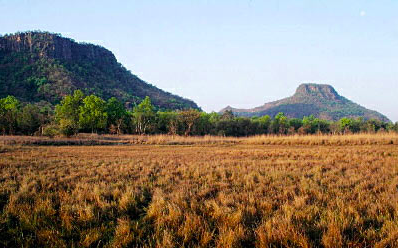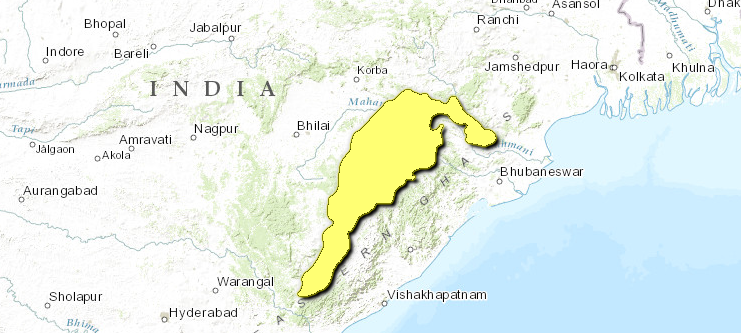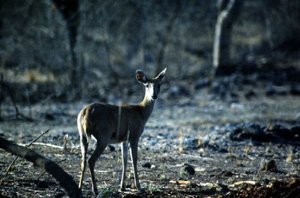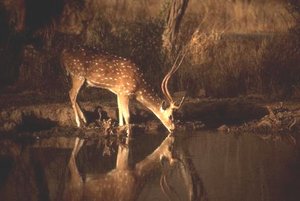Northern dry deciduous forests

Bandhavgarh National Park, Madhya Pradesh, India. (Photograph by © WWF-Canon/Martin Harvey)
Introduction The Northern Dry Deciduous Forests ecoregion (Northern dry deciduous forests) is neither exceptionally species-rich nor high in numbers of endemic species. But it does harbor several large vertebrates, including Asia's largest and most charismatic carnivore, the tiger (Panthera tigris). This ecoregion also represents the northernmost extent of dry deciduous forests in India.
Location and General Description
The ecoregion extends across the Indian states of Bihar, Orissa, and Madhya Pradesh. It represents a north-south-directed island of dry deciduous forests in the rainshadow of the Eastern Ghats Mountain Range and is completely surrounded by the Eastern Highlands Moist Deciduous Forests. As with the rest of the Deccan Plateau, the ecoregion's geological history dates back to the Cretaceous, when it was part of southern Gondwanaland.
The forest type in the ecoregion corresponds to the Shorea-Buchanania-Cleistanthus and Shorea-Cleistanthus-Croton vegetation mapped by Gaussen et al.. Most of these forests are open scrub influenced by human activities. The original sal (Shorea robusta)-dominated, multistoried vegetation has been replaced by teak (Tectona grandis), which favors drier conditions. In many areas, intensive livestock grazing, fire, and nontimber forest product harvest have converted the habitat to scrub and savanna woodland.
The vegetation is made up of associations of Anogeissus latifolia, Dalbergia latifolia, Pterocarpus marsupium, Stereospermum suaveolens, Spondias pinnata, Cleistanthus collinus, Acacia lenticularis, Flacourtia indica, Boswellia serrata, Butea monosperma, Sterculia urens, Cochlospermum religiosum, and Euphorbia nivulia. Gregarious patches of Dendrocalamus strictus tend to occur in moister areas. Cleistanthus collinus can release substances toxic to other species; therefore, monospecific stands can occur in places.
Biodiversity Features
Like many of the Deccan Plateau dry forest [[ecoregion]s], this region does not harbor large numbers of endemic species, nor is it exceptionally rich in biodiversity. The known mammal fauna consists of sixty-eight species. There are no ecoregional endemic species, but the threatened species include the tiger, wild dog (Cuon alpinus), sloth bear (Ursus ursinus), and chousingha (Tetracerus quadricornis).
The 261 bird species in the ecoregion do not include endemic species. The Indian grey hornbill (Ocyceros birostris) and Oriental pied-hornbill (Anthracoceros albirostris) need tall, mature trees for nesting and can be used as focal species for conservation management.
Current Status
More than three-fourths of the [[ecoregion]'s] natural habitat has been cleared or degraded. But a few mid-sized (i.e., more than 2,000 kilometers 2 (km)) blocks of intact habitat still remain. The four protected areas in the ecoregion (Table 1) amount to just over 1,400 kilometers2, representing about 2.5 percent of the ecoregion area. But of these, only one exceeds 500 kilometers2.
|
Table 1. WCMC (1997) Protected Areas That Overlap with the Ecoregion. Protected Area Area (km2) IUCN Category Sunabeda 600 IV Kanger Ghati 230 II Debrigarh 340 IV Gomarda 290 IV Total 1,460 Ecoregion numbers of protected areas that overlap with additional ecoregions are listed in brackets. (Northern dry deciduous forests) ==Types and Severity of Threats== Land clearing and degradation remain the primary threat to the remaining habitat. Fires are regularly set to encourage grazing lands for livestock. Extensive poaching and collection of nontimber forest products by the tribal communities are also a serious concern. But degradation threats from industry and timer companies also are high. The large tribal populations in these areas are also shifting from subsistence to more materially demanding lifestyles. The growing populations and economic aspirations and shrinking resources result in conflicts with conservation interests and authorities. Until these problems are addressed effectively, the conflicts will increase. The Naxalite conflicts in Andhra Pradesh and at the junction of Madhya Pradesh-Maharashtra-Andhra Pradesh prevent effective government management and protection of conservation areas (especially protected areas and reserve forests). The conflicts are also funded by poaching of rhinoceroses, tigers, and elephants. ==Justification of Ecoregion Delineation== In a previous analysis of conservation units, Rodgers and Panwar divided the Deccan Peninsula into five biotic provinces. The Eastern Highlands (6C) and Chhota-Nagpur (6D) biotic provinces of Rodgers and Panwar contain this large patch of dry deciduous forests, which is surrounded by an extensive area of moist deciduous forests. In keeping with our definition of an ecoregion (i.e., an ecosystem of regional extent) and following our rules for ecoregion delineation (represent distinct vegetation types of [[region]al] extent in separate ecoregions), we extracted the dry deciduous forests (as mapped by MacKinnon 1997) from the surrounding moist deciduous forests and represented them with the Northern Dry Deciduous Forests. ==Additional Information on this Ecoregion== * For a shorter summary of this entry, see the WWF WildWorld profile of this ecoregion. * To see the species that live in this ecoregion, including images and threat levels, see the WWF Wildfinder description of this ecoregion. * World Wildlife Fund Homepage ==Further Reading== * Gaussen H., V.M. Meher-Homji, Blasco, F., Delacourt A., Fontanel, J., Legris P., and Troy J.P. 1973. International map of the vegetation and of environmental conditions. Orissa Sheet, French Institute. Pondicherry. * Puri, G.S., Gupta, R.K., and Meher-Homji, V.M.P.S. 1989. Forest Ecology Volume 2. New Delhi, India: Oxford & IBH Publishing Company. ISBN 812040355X. * World Wide Fund for Nature (WWF) and The World Conservation Union (IUCN) 1995. Centres of Plant Diversity: A Guide and Strategy for Their Conservation. Volume 2: Asia, Australasia and the Pacific. Cambridge: IUCN. ISBN 283170197X. * IUCN. 2000. 2000 IUCN Red list of threatened species. Viewed November 2000. The IUCN Species Survival Commission and the International Union for Conservation of Nature and Natural Resources (IUCN – The World Conservation Union).Updated: 2007 IUCN Red List of Threatened Species. * MacKinnon, J. 1997. Protected areas systems review of the Indo-Malayan realm. Canterbury, UK: The Asian Bureau for Conservation (ABC) and The World Conservation Monitoring Center (WCMC)/ World Bank Publication. ISBN 2880326095. * Rodgers, W. A. and H. S..Panwar. 1988. Planning a wildlife protected areas network in India. Vol 1 and 2. Dept of Environment, Forests, and Wildlife/Wildlife Institute of India report. Wildlife Institute of India. |
|---|


